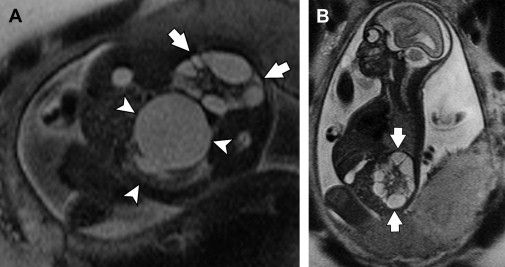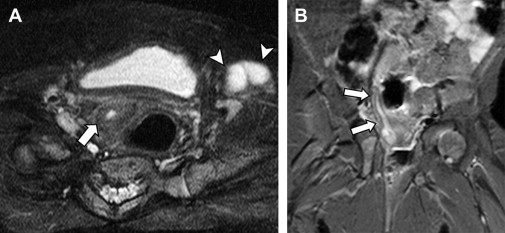Although many Müllerian duct anomalies do not require treatment, surgical intervention is sometimes necessary to enable sexual activity or to preserve fertility. The identification of these anomalies is important for optimal clinical management or surgical treatment. Magnetic resonance (MR) imaging is a robust method for adequately evaluating and characterizing uterine and vaginal anomalies. The information provided by MR imaging allows for a more complete understanding of the malformation, facilitating management decisions and potentially changing the outcome. In this article, the embryology, classification, and MR imaging findings of Müllerian duct and related anomalies in children and adolescents are reviewed.
Key points
- •
Müllerian duct anomalies represent a more frequent entity than previously believed.
- •
Various magnetic resonance imaging sequences allow detection of specific tissue and fluid elements that may have diagnostic implications, such as blood products, fibrous tissue, or calcifications.
- •
Best results for correction of genital tract outflow obstruction are achieved at the first attempt; therefore, accurate initial diagnosis is of utmost importance.
- •
Strong consideration should be given to evaluating potential genital tract anomalies in females with antenatal or postnatal diagnoses of renal agenesis, ureteral ectopia, or a multicystic dysplastic kidney with or without associated hydrocolpos.
- •
In clinical practice, it is important to distinguish between septate and bicornuate uteri, because the management and therapeutic interventions for these entities are different. However, this task is challenging and not always possible in pediatric patients.
Introduction
Developmental abnormalities of the Müllerian duct system encompass a wide spectrum of anomalies resulting from nondevelopment, defective fusion, or incomplete septal regression during fetal life. The prevalence of Müllerian duct anomalies (MDAs) is unclear, because many are asymptomatic and may go unnoticed. In women with a previous history of infertility and miscarriage, the prevalence may be as high as 25%. Previously reported prevalence in unselected populations ranged from 0.4% to 1%. In 2 more recent meta-analyses, Chan and colleagues and Saravelos and colleagues reported a prevalence of 5.5% and 6.7%, respectively, for MDAs in the general population. Therefore, MDAs represent a more frequent entity than previously believed. This fact might be at least partly related to the availability of noninvasive and accurate diagnostic imaging methods. MDAs are also commonly inaccurately reported and ineffectively managed. An accurate initial diagnosis is of utmost importance, because the best surgical results for correction of outflow tract obstruction are achieved at the first attempt.
The most common types of MDA in the general population are, in order of frequency, the arcuate uterus, septate and subseptate defects, and the bicornuate uterus. Environmental factors, chromosomal abnormalities, and hormonal factors are considered to be possible mechanisms in the development of MDAs, although most of the cases are idiopathic.
MDAs are frequently associated with renal or axial skeletal anomalies. Consequently, strong consideration should be given to evaluating potential genital tract anomalies in women with antenatal or postnatal diagnoses of renal agenesis, ureteral ectopia, or a multicystic dysplastic kidney with or without a sonographically visible pelvic mass ( Fig. 1 ). Prenatal imaging may often detect a renal abnormality before identification of an associated uterine anomaly. Anorectal malformations may also be associated with this condition. It is important to be aware of this association, because it may have management implications. In such patients, the concomitant performance of a sigmoid colovaginoplasty or vaginal pull-through at the time of the anorectoplasty may potentially improve their outcome.

An increased incidence of ovarian maldescent, which is defined as ovaries that are positioned at or above the level of the iliac artery bifurcation on magnetic resonance (MR) imaging, has been reported in association with MDAs. Inguinal ovaries have also been reported in association with uterine malformations ( Fig. 2 ).

This article reviews the embryology, classification, and MR imaging findings of Müllerian duct and related anomalies in children and adolescents. Understanding the proper imaging techniques as well as the characteristic MR imaging appearance of various MDAs aids in accurate diagnosis and thus contributes to optimal patient care.
Introduction
Developmental abnormalities of the Müllerian duct system encompass a wide spectrum of anomalies resulting from nondevelopment, defective fusion, or incomplete septal regression during fetal life. The prevalence of Müllerian duct anomalies (MDAs) is unclear, because many are asymptomatic and may go unnoticed. In women with a previous history of infertility and miscarriage, the prevalence may be as high as 25%. Previously reported prevalence in unselected populations ranged from 0.4% to 1%. In 2 more recent meta-analyses, Chan and colleagues and Saravelos and colleagues reported a prevalence of 5.5% and 6.7%, respectively, for MDAs in the general population. Therefore, MDAs represent a more frequent entity than previously believed. This fact might be at least partly related to the availability of noninvasive and accurate diagnostic imaging methods. MDAs are also commonly inaccurately reported and ineffectively managed. An accurate initial diagnosis is of utmost importance, because the best surgical results for correction of outflow tract obstruction are achieved at the first attempt.
The most common types of MDA in the general population are, in order of frequency, the arcuate uterus, septate and subseptate defects, and the bicornuate uterus. Environmental factors, chromosomal abnormalities, and hormonal factors are considered to be possible mechanisms in the development of MDAs, although most of the cases are idiopathic.
MDAs are frequently associated with renal or axial skeletal anomalies. Consequently, strong consideration should be given to evaluating potential genital tract anomalies in women with antenatal or postnatal diagnoses of renal agenesis, ureteral ectopia, or a multicystic dysplastic kidney with or without a sonographically visible pelvic mass ( Fig. 1 ). Prenatal imaging may often detect a renal abnormality before identification of an associated uterine anomaly. Anorectal malformations may also be associated with this condition. It is important to be aware of this association, because it may have management implications. In such patients, the concomitant performance of a sigmoid colovaginoplasty or vaginal pull-through at the time of the anorectoplasty may potentially improve their outcome.
An increased incidence of ovarian maldescent, which is defined as ovaries that are positioned at or above the level of the iliac artery bifurcation on magnetic resonance (MR) imaging, has been reported in association with MDAs. Inguinal ovaries have also been reported in association with uterine malformations ( Fig. 2 ).
This article reviews the embryology, classification, and MR imaging findings of Müllerian duct and related anomalies in children and adolescents. Understanding the proper imaging techniques as well as the characteristic MR imaging appearance of various MDAs aids in accurate diagnosis and thus contributes to optimal patient care.
Embryology
The Müllerian (or paramesonephric) ducts are the primal components of the female genital tract, giving rise to the fallopian tubes, uterus, cervix, and the upper two-thirds of the vagina. Given the dual origin of the vagina, the upper two-thirds originate independently from the Müllerian ducts, whereas the lower one-third originates from the urogenital sinus ; vaginal anomalies, such as septa, duplication, and aplasia/hypoplasia, may or may not coexist with uterine anomalies.
The normal development of the uterus is completed in 3 stages: organogenesis, fusion, and septal resorption. Uterine anomalies may be caused by failed organogenesis of 1 or both ducts, resulting in uterine hypoplasia/agenesis or a unicornuate uterus. Abnormal or absent fusion of the ducts may cause the formation of a didelphys or bicornuate uterus. Failure of septal resorption, once the Müllerian ducts have fused, may result in a septate or arcuate uterus. In addition, a T-shaped uterus, which is an unusual anomaly in uterine morphology, was reported in the past in association with diethylstilbestrol (DES) exposure.
Imaging
During the neonatal period, evaluation of the uterus by transabdominal ultrasonography (US) is facilitated by the effects of maternal hormones, avoiding the need for MR imaging (and possible sedation). As the influence of maternal hormones on the uterus diminishes, the uterus becomes small and tubular, precluding optimal evaluation. Thus, some advocate follow-up evaluation be delayed until the pubertal period in suspicious cases. Transvaginal three-dimensional (3D) US, which seems to be highly accurate for the diagnosis and classification of Müllerian anomalies, is a recommended method for the initial evaluation of adult women ; however, this procedure is not safely performed in pediatric or sexually nonactive adolescent patients. Transabdominal US may often provide enough information for making management decisions and prognostication. However, the findings may not always be conclusive, especially when the ovaries are not definitively identified or when the presence or absence of Müllerian remnants cannot be determined with high confidence. In these instances, MR imaging is usually recommended for a complete assessment.
MR imaging is widely considered to be the standard for MDA evaluation, especially in patients who are not sexually active, with reported diagnostic accuracies of almost 100%. Recent advances in pediatric pelvic MR imaging, including more rapid sequences, isotropic volumetric image acquisition, and higher field strengths (with an increase in the MR signal-to-noise ratio on newer 3-T scanners compared with the classic 1.5-T systems), have allowed not only faster examinations but also improvements in the overall image quality. Various pulse sequences allow evaluation and characterization of a range of tissues and fluids and accurately detect specific components that may have diagnostic implications, such as blood products, fibrous (vs muscular) tissue, or calcifications.
MR imaging protocols for the evaluation of MDAs vary across institutions. However, as a rule of thumb, water-sensitive sequences, such as T2-weighted sequences with or without fat suppression, are considered to be the pillars of female pelvic imaging. They allow for optimal visualization of the uterine zonal anatomy and clearly distinguish among the hyperintense endometrium, the hypointense junctional zone/inner myometrium, and the intermediate signal intensity of the outer myometrium ( Fig. 3 ). Initial T2-weighted sequences are usually performed in the sagittal plane to identify the position and orientation of the uterus. These sequences are followed by images that are parallel to the long axis and short axis of the uterus. Images oriented along the long axis of the uterus in the coronal-oblique plane are crucial for depicting the external fundal contour. Alternatively, high-resolution, volumetric, 3D T2-weighted fast spin-echo or balanced steady-state free precession images may be obtained, and multiplanar reformatting in any desired plane can be performed retrospectively at a work station, thereby potentially decreasing the total scan times ( Fig. 4 ). Axial fat-suppressed T1-weighted images are also obtained to evaluate for the presence of blood products in cases of obstruction and hemato(metro)colpos. The uterus has a uniform signal intensity on T1-weighted images, which are therefore of limited value for the assessment of the uterine zonal anatomy.
Evaluation of the kidneys and renal collecting systems is recommended in patients with MDAs, because as many as 40% of the patients have concomitant renal anomalies. The common associated anomalies are unilateral agenesis, ectopia, renal hypoplasia, multicystic dyspalstic kidney, and hydronephrosis. Such evaluation can be accomplished by a single-shot fast spin-echo sequence providing a large field of view in the coronal plane, which can capture the renal fossae, expected course of ureters, and urinary bladder ( Fig. 5 ) .
Classification
There is considerable controversy regarding the classification and nomenclature of MDAs. The most widely accepted classification system is the one developed in 1988 by the American Fertility Society (AFS), now known as the American Society of Reproductive Medicine ( Fig. 6 ). The anomalies are grouped based on similar uterine anatomy and the impact on pregnancy outcome/fetal survival. This system classifies anomalies into 7 major anatomic uterine types, with additional subdivisions ( Box 1 ).
Class I: Müllerian hypoplasia or agenesis
- a.
Vaginal
- b.
Cervical
- c.
Fundal
- d.
Tubal
- e.
Combined
- a.
Class II: unicornuate uterus (agenesis or hypoplasia of 1 of the Müllerian ducts)
- a.
Rudimentary horn with a communicating cavity
- b.
Rudimentary horn with a noncommunicating cavity
- c.
Rudimentary horn without a cavity
- d.
Complete absence of 1 horn
- a.
Class III: uterus didelphys (failure of lateral fusion of the Mullerian ducts)
Class IV: bicornuate uterus (incomplete Mullerian ductal fusion at the level of the body and fundus)
- a.
Complete
- b.
Partial
- a.
Class V: septate uterus (incomplete resorption or nonresorption of the uterovaginal septum)
- a.
Complete
- b.
Partial
- a.
Class VI: arcuate uterus (near-complete resorption of the uterovaginal septum with a trivial inner notch in the fundus and without external cleft)
Class VII: DES-related uterine hypoplasia and luminal changes
Despite its widespread use, the AFS classification is by no means accepted by all. There are several drawbacks, especially the absence of a system for classifying a uterus that shows 2 or more anomalies from different classes. This classification system is best suited to postpubescent females, because the neonatal or prepubescent uterus may be too small to allow definitive characterization. For example, by definition, the external fundal cleft in a bicornuate uterus must measure at least 10 mm. In prepubescent girls, the entire normal uterus may measure only 20 mm, and the typical findings sought for the differentiation between bicornuate and septate uteri in premenopausal women, such as the criteria for fundal contours and measurements, may not be applicable to fetuses, neonates, infants, or prepubescent females. There is also debate regarding whether an arcuate uterus should be included in the same class with a septate uterus, should be placed in a separate class within the classification system, or should be considered a normal variant and thus excluded from the classification system.
The classification system refers only to the uterus and lacks a systematic approach to obstructive anomalies, which are usually caused by cervical or vaginal anomalies and are responsible for many of the symptoms, especially in the pediatric population.
Because of the difficulty in classifying MDAs using this system, perhaps the best approach may be to thoroughly describe the anatomy, including the number of cervices and uterine horns, (or lack of communication) of any atrophic horn, and the MR signal characteristics, if present, of any uterine or vaginal septa and any evidence of obstruction. Although many anomalies do not require treatment, in certain MDA cases, surgery may be necessary to enable sexual activity or to preserve fertility. In these cases, a thorough but concise description may best guide the surgical treatment or clinical management. Given the lack of standardized terminology, communication and joint reviews of cases between surgeons and radiologists are essential to ensure that appropriate clinical decisions are made and that inconsistencies in terminology do not lead to the incorrect decisions or to differences in management. A multidisciplinary team of health care workers (including psychological counselors) is typically necessary to optimally manage these patients and to prepare them to adapt to their congenital anomalies, both at the time of diagnosis and later in life, especially in adolescents with class I anomalies.
Class I Anomalies
Uterine agenesis or hypoplasia accounts for approximately 5% to 10% of uterine anomalies and is caused by failure of the Müllerian ducts to develop at approximately 5 weeks of gestation, resulting in various degrees of agenesis or hypoplasia of the upper two-thirds of the vagina, cervix, or uterus. Type I Mayer-Rokitansky-Küster-Hauser (MRKH) syndrome is the extreme form of this anomaly and consists of complete agenesis of the uterus, cervix, and proximal two-thirds of the vagina. Because normal ovaries are usually present, this disorder is characterized by a normal female phenotype, but primary amenorrhea during adolescence ( Fig. 7 ). If Müllerian duct agenesis or hypoplasia occurs with renal, ear, or skeletal anomalies, then the terms MURCS (Müllerian duct aplasia, unilateral renal aplasia, and cervicothoracic somite dysplasia) association or type II MRKH syndrome are sometimes used.

Stay updated, free articles. Join our Telegram channel

Full access? Get Clinical Tree




